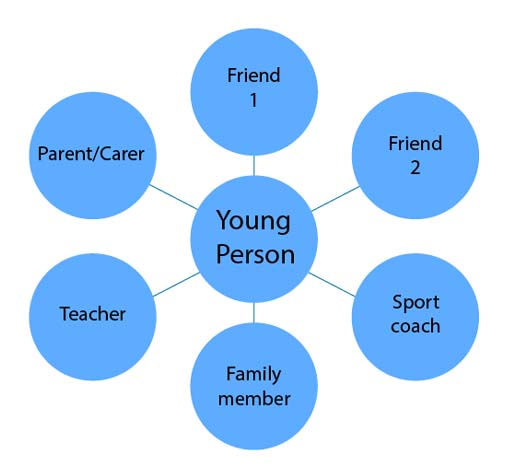1.1 Fostering supportive networks
The value of a supportive social and family network should not be underestimated. In Session 5, you found that having a supportive social network is a key feature of resilience. A strong social network also instils a sense of belonging, which can promote wellbeing. Psychologist Nathaniel Lambert and colleagues (Lambert et al., 2013, p.1425) identified that ‘Having a sense of belonging is to have a relationship with people, or a group of people, that brings about a secure feeling of fitting in.’ Therefore, when considering a person’s social network it will also be useful to think about the quality of the relationships.
Research has shown that parents, best friends, peers, relatives, siblings, teachers and other practitioners and members of the community can all be a source of secure relationships for a young person (Buckley et al., 2012). Look at the diagram in Activity 2, which gives an illustration of a close social network for a young person.
Working out who is part of a young person’s social network can be a first step towards helping the young person to access support from trusted sources. The next activity will help you to map out the social network of a young person you know, and invite you to do the same for yourself.
Activity 2: Social support networks
Spend a few minutes thinking about the people in the life of a young person you know well. It could be a family member, friend, neighbour, or someone you know from education or sports activities. It might be a young person you know about through another adult.
Fill in the social network for this young person the best you can. Then, consider which of these relationships might be the strongest for providing a sense of belonging or trust. You might find it helpful to think back to Ken Ginsberg’s advice about how to support an adolescent with their competence in organisational, communication, self-advocacy skills, and to understand how to handle peer pressure.
Why not do the same for yourself? Being in a position to support others means that you also need a good social network for your own wellbeing. Consider who might be able to provide good quality support to you. It may be that there are a few individuals who provide slightly different aspects of the support you need.
Discussion
There are no right and wrong answers to this activity as each individual’s personal circumstances are different. It is likely that some of the relationships you have identified include people the young person knows really well and may be emotionally close to, such as family members or friends, while other relationships, though important, are with people whom they are not emotionally close to, such as fellow students, members of a social group or team members. It is important to note that emotional closeness in relationships of course depends upon the quality of the relationship they share with network members. What the activity highlights is that each person is part of a network of relationships of different kinds and varying degrees of importance.
Note that networks may change over time; they grow, shrink and shift. As a person moves through adolescence, their peers may become more important than their close relatives. School transitions and changing family dynamics can be disruptive and adapting to these changes should be seen as a natural part of development.

